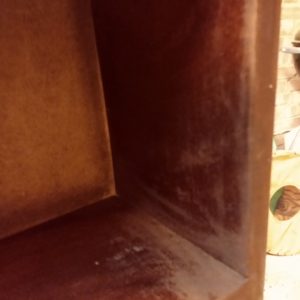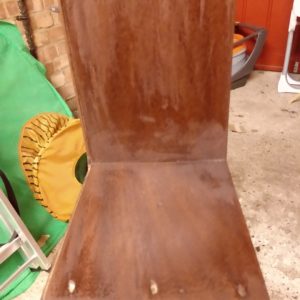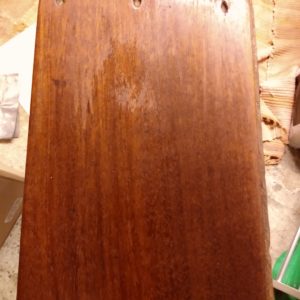Hello,
I’m looking for advice as I’m currently stuck. I’ve never done any sort of wood restoration project before.
I’ve been fixing up a bookcase I inherited years ago – I don’t know what wood it is, it was very dark but is now a nice reddish colour. I sanded it for ages, down to 400 grit. I’ve been applying pure tung oil for months – I mixed the first 3 coats with decreasing % of citrus solvent and then pure Tung oil (liberon) I think I’m on about 9 coats. I have been leaving quite a long time between coats (about 3 weeks at one point, mostly a week.) Using fine steel wool between coats.
I’ve mostly been doing very very light coats, wiping it all down thoroughly. It was building up a nice, even low satin sheen. But I got interrupted during the last one and I think it’s ruined things! I checked it earlier and there’s greyish deposit in several places, also the edges look dull. It’s like there’s excess that has pooled/dried in some areas, and others look like there’s not enough – is this right?
How doI move forward? Do I have to sand it off ??? Or can I wipe it off/ dissolve it with the citrus oil solvent? Would that affect the many coats I’ve already done – would I be back to square one? And how do I know when I’m done? Meaning, how do you know ‘this will be my last coat.’?
I’m really gutted as it was coming up so nice and smooth and it just suddenly looks awful. Any tips will be gratefully received.
(Please be kind, I’ve no idea what I’m doing and it’s my first project)


















Replies
It's difficult to know where to start...
Liberon is not 'pure tung oil' - in reading the chemical composition, I don't see any reference to tung oil (which is derived from a China-based plant), and the Liberon website just says that it's a mixture of 'oils, dryers, and resins' - with Naptha listed as a primary ingredient. It's odd that all of the product reviews are positive... makes one a bit skeptical.
Citrus Solvent - you have me on this one; as I've never heard this used on wood, or within wood finish mixtures - I'd be looking more for cutting a urethane or tung oil with mineral spirts or boiled linseed oil.
A third concern is the amount of time and coats and drying time you've spent to get to this point. There is no reason that a Naptha-based product should dry this slowly (Naptha flashes-off almost immediately upon application).
As to next steps... I just don't know this product or mixture to recommend a corrective action.
Where did you find the chemical composition of Liberon Pure Tung Oil ? I read their site and both MSDS of the pure and quick drying Tung Oil and the first contains no solvent or for that matter no hazardous component and the second has between 10% and 25 % of them.
From the Rockler Website... for 'Liberon Finishing Oil' - it's quite possible that these are two different products.
3. COMPOSITION / INFORMATION ON INGREDIENTS Formula: F0LJD02
Component(s) contributing to the • NAPHTA LOURD HYDROTRAIT• hazard: Conc. wt.(%): 60 < C <= 70 - Symbol(s): Xn - R-phrase(s): 65-66 • CARBOXYLATE DE COBALT(2+) - CAS no: *68409-81-4 Conc. wt.(%): 0 < C <= 1 - Symbol(s): Xn - R-phrase(s): 22-38-43 • ACIDE OCTANOIQUE, SEL DE ZI - CAS no: 18312-04-4 Conc. wt.(%): 0 < C <= 1 - Symbol(s): Xi N - R-phrase(s): 36/38-51/53
I stand corrected - there is a Liberon Pure Tung Oil... I'll look at this...
Well, I have to admit... I read the MSDS for this, and I didn't find 'Tung Oil" mentioned anywhere...
I'm using the pure tung oil, not the finishing oil. I bought the pure tung oil as I was looking for something as minimally toxic, with as few chemicals and VOCs, as possible, for environmental and health reasons. The citrus solvent was recommended to me by a friend who is an artist and carpenter. I'm a total novice, but was happy to experiment.
I should have been clearer. The project hasn't been taking me so long because each coat has been taking a long time to dry - each coat is only taking a couple of days or so; it's been quite dry when I got around to doing the next one. It's taken me so long because I have a young baby and it's difficult to find the time! Each coat has been very easy up til now, just a light rub with steel wool, I've had no clogging or sticky residue.
I haven't used the diluted oil since before Xmas, I don't think that's the issue. It has been working really well as I was only doing light coats and wiping it well off. I've only run into a problem after all this time as I was interrupted in the middle of the last one, as my toddler had an accident and we had to go to a&e. So it took me a couple of days to get back to it. It's now dried unevenly and puddled in a few places, & looks patchy in others like it didn't have quite enough oil.
How do I fix this? Do I need to sand down the whole bookcase very thoroughly? Or should I carefully apply solvent with a cloth and then try using steel wool to lift the gunk off the thicker areas?
Ah, I wrote a reply earlier but it seems to have vanished. 🤷
It's not been taking me a long time because the coats are taking a long time to dry - it's taking me a long time because I have a young baby and it's hard to find the time, so it gets left for ages. On the contrary, each coat has been nicely dry as I've only been doing thin light coats and wiping it all well down. When I rub it down with steel wool it's never clogged or sticky.
It's definitely the pure tung oil I'm using, not the finishing oil. I went for this as I wanted something that was more environmentally friendly and with lower levels of VOCs. Ditto the citrus solvent, which was recommended by a friend who's an artist and carpenter, as I don't want to use turps or mineral spirits.
I've not had a problem up until now, and it's only because I was interrupted in the middle of my last coat (my toddler had an accident) and wasn't able to attend to it for a couple of days, by which time it had dried all tacky and looks terrible 😔
How can I fix this?
Do I have to sand the whole thing down very thoroughly? Or can I use solvent to wipe off the thicker gunky areas, maybe give it a good rub with steel wool, and then reapply?
Never, ever, experiment with a new finish on a finished project. Use scrap wood.
I wouldn't use any kind of oil on a book case, either. And I don't trust most oil finishes, because more often than not they aren't what they claim to be.
I wouldn't consider any sort if finish that requires weeks in between coats to dry. Chances are, it will never be fully cured.
Water based finishes are the most environmentally and health friendly, if that's your concern.
Mdorsam, the MSDS will not mention elements that are not hazardous. The pure tung oil msds mentions no hazardous component and they were not obligated to produce one, I suspect they did to fill commercial users requirements that required a msds follow each product. If you look up the quick dry tung oil from Liberon, you will notice it mentions only hazardous components up to 25% content, you then can conclude the remaining 75 to 90% of the product in the can is pure tung oil.
I remember a furniture restauration method called tung-oil quench that might do the trick, I have the recipe in front of me from « the furniture bible « . Basically, you rub the surfaces with a warm mixture of 2 parts oil in one part turpentine using superfine 0000 steel wool. Do not warm on a heated surface, use a pot of boiling water as a heating source. Wipe dry and let sit overnight then apply pure tung oil , let sit 5 minutes and wipe dry, repeat after 24 hours until you are satisfied.
I suspect the bookcase was not stripped of all its finish before you started applying the oil, this would normally require chemical strippers followed by medium grit sanding down to fine, say 180/220 grit. Over sanding in the finer grits can also cause burnishing of the surface which results in blotching similar to what is seen.
JohnC2, it's not taking weeks to dry - it's no more than 48 hours. It's only taken me this all time because I have simply can't get it done faster with kids running around!
I was planning on finishing it with a paste wax of some sort but hadn't got that far yet.
Thank you for the advice about water based finishes. Do you have a recommendation?
Gulfstar, thank you for the tip about the previous finish not being properly stripped, I think that might be it. I did not use any chemical strippers, only sanded. I was using 320-400 grit in between coats - is that perhaps causing 'over burnishing'? Should I stick to steel wool?
I'll give the warm oil thing a bash, seems a good shout.
I'll jump in here albeit a little late. I love tung oil as a finish and I use it a lot, you can find examples here: BeasleySevinDesigns.com . I also use citrus solvent as a thinner because I live in an environmentally sensitive area (Chesapeake Bay estuary) and am keenly aware that whatever is in my shop, ends up in the bay. I make sure I use 100% pure tung oil, usually purchased from The Real Milk Paint Company, which also carries citrus solvent.
Here are a few bits to consider.
Before it's fully cured, tung oil reacts poorly to sunlight. If your last coat got a dose of sunshine, it would cause graying.
Tung oil soaks into the wood and cures, vs sittingon top. Therefore, you should only need 45 minutes between coats, not weeks or days.
When you put it on, let it sit 45 min, wipe off puddles, put the next coat on. When 85% of the wood is still wet after 45 min, that was your last coat. After your last coat, have a look every hour or two to wipe off any puddles or wet spots, sometimes it "weeps" as it cures. When it's done weeping, keep it out of the sun for about 30 days and you are good to go.
As for the current grey spots, start with some solvent and .0000 steel wool. If that doesn't work, I am afraid you are back to sanding. Best of luck.
Hi Beasley7, ta very much - that was very helpful. It's been in the garage the whole time, so no sun. Think it's just excess b/c I had to drop everything mid-coat to rescue the kidlet, I didn't get to wipe it down at all properly so it was really thick in parts.
I'm going to try your idea, so thanks!
This forum post is now archived. Commenting has been disabled